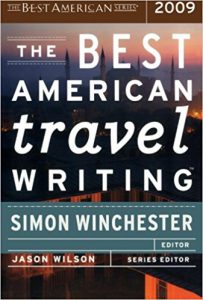The Best American Travel Writing 2009, edited by Simon Winchester
The Best American Travel Writing 2009
Edited by Simon Winchester
Mariner/Houghton Mifflin Harcourt
Five Stars
Reviewed by Jessica Gribble
You know you’re reading a good anthology when the introduction is memorable! The Best American Travel Writing 2009; opens with an introduction by Simon Winchester, famous for his books filled with a journalist’s level of detail about interesting people and places. He introduces us to a very bright young woman who doesn’t know her geography and implicates us—I don’t know my geography either! But I’ve spent long, otherwise dull hours in the car looking at a map, wondering where the names come from, how there can be so much land on the earth, and when I’ll get to see whichever place name is currently tickling my fancy. After Winchester’s introduction, you’re ready to travel and willing to read about any old place someone else has gone and found interesting enough to write about.
The essays in this volume are consistently excellent. I’ll simply describe some of the standouts for you and then leave you to your armchair travels. Of course, some essays will appeal more to some people than others. I loved reading about James Bond’s ski scenes, having been bored by plenty of Warren Miller movies that never show the other side of the camera. Jay Cowan perfectly captures the gorgeous Alpine scenery, daring stunt-skiers, and camera tricks in Tracking Down James Bond. I began reading Frank Bures’s essay on magical penis dismemberment with muted hilarity and disbelief: how can people believe this stuff? And, secondarily, how can you plan a trip around researching it? By the end, I could see that dismemberment—real or imagined—was affecting people and their relationships, and that those people and their landscapes had affected Bures. Bronwen Dickey infuses Appalachia and the Chattooga River with the wildness and beauty that Deliverance overwhelmed with its portrayal of the area as a haven for violent rednecks. Chuck Klosterman, usually a chronicler of the hip and the angst-ridden heart, writes about how his German students experience the United States through its celebrities. Tony Perrottet writes the least scandalous essay I can imagine about touring locations famous for the eros and perversions stored or perpetrated within (he doesn’t find much, but you get a good sense for each place). In “A Dip in the Cold,” Lynne Cox tours some geography almost no one else in the world will ever see; the frigid water in the Northwest Passage, where she swims surrounded by icebergs and lives to write the essay. Matthew Power managed to make me hate his companions, the Mississippi River, freganism, and homemade rafts while still enjoying his writing. Those who love Disney World might be slightly put off by Seth Stevenson’s “The Mecca of the Mouse,” but its behind-the-scenes view of the Disney empire is fascinating, exhausting, and richly descriptive. In “Hotels Rwanda,” by Jay Kirk, we tromp around in the Rwandan jungle, looking for the elusive mountain gorilla and learning a thing or two about ecotourism, the jungle, and his human companions. Another exploration of the wild, and wild animals, leads us into Caroline Alexander’s “Tigerland,” set in the jungle of India. It brings to mind Rudyard Kipling stories, but is set in our present, where tigers are protected from people but still manage to eat one occasionally.
As all good travel writing should do, this anthology takes us to places we’ll never see (and may never have heard of). It inspires journeys and cleaves faithfully to the writing teacher’s admonition to “show, not tell.” These authors are masters of bringing the world into our imaginations. So take Simon Winchester’s advice: get interested in geography and go wandering abroad, overseas, somewhere foreign!
